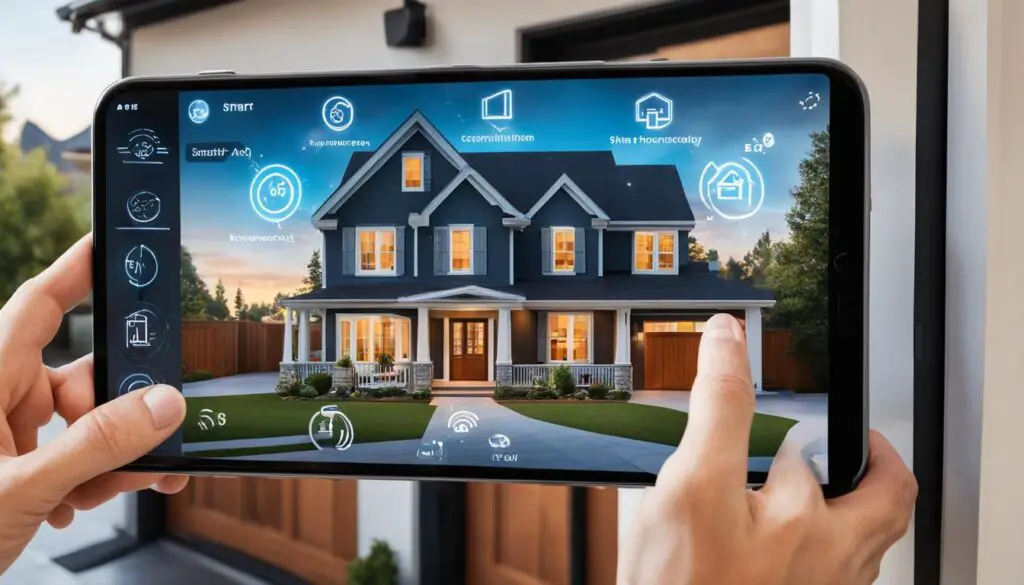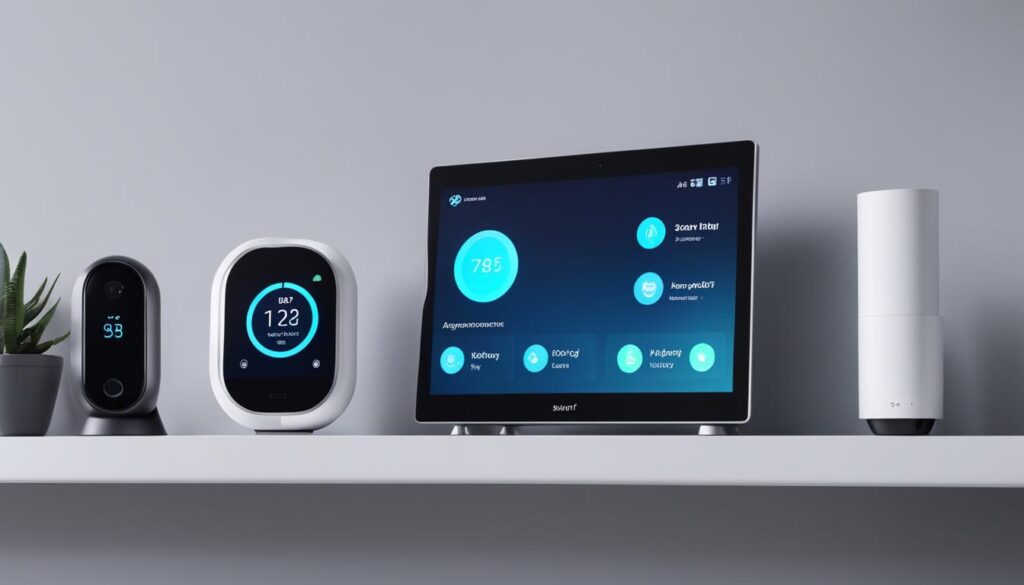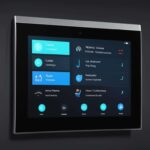Welcome to the world of smart homes! As a first-timer, you’ve made a fantastic choice to embrace the convenience and advanced technology that smart home systems offer. However, it’s crucial to understand the importance of smart home maintenance to ensure that everything runs smoothly and your investment continues to provide value for years to come.
From updating firmware to troubleshooting common issues, I’m here to provide you with essential advice on maintaining your smart home. Whether you have security cameras, thermostats, lighting controls, or virtual assistants, these tips will help you keep your devices in top shape and enjoy the full benefits of a smart home.
Table of Contents
Key Takeaways:
- Regularly update firmware and software to keep your smart home running smoothly.
- Clean devices and check for firmware updates to maintain optimal performance.
- Prioritize cybersecurity by implementing strong passwords and enabling two-factor authentication.
- Be cautious about the third-party apps and services you use to protect against cyber threats.
- Know how to troubleshoot common issues like connectivity problems and device malfunctions.
By following these simple yet effective maintenance tips, you’ll be well-equipped to manage your smart home like a pro. Let’s dive in and explore everything you need to know about smart home maintenance, starting with understanding smart home systems and devices.
Understanding Smart Home Systems and Devices
Smart homes are equipped with a variety of systems and devices designed to make our lives easier and more convenient. These include security cameras, thermostats, lighting controls, and virtual assistants like Amazon Echo or Google Home. Understanding how these components work and how to maintain them is crucial for the smooth operation of your smart home.
Regular maintenance of your smart home systems and devices is necessary to ensure optimal performance and longevity. Here are some key maintenance tasks to keep in mind:
- Regularly update firmware and software: Just like any other technology, smart home systems and devices receive regular updates to improve performance and add new features. Make sure to regularly check for firmware and software updates and install them to keep your devices up to date.
- Clean devices: Over time, dust and debris can accumulate on your smart home devices, affecting their functionality. Wipe down your devices with a soft, lint-free cloth regularly to keep them clean and free from obstructions.
- Check for firmware updates: In addition to updating firmware and software, it’s important to check for firmware updates specific to each device. These updates may include bug fixes or security enhancements. Refer to the manufacturer’s instructions to learn how to check for and install firmware updates specific to your devices.
By staying on top of these maintenance tasks, you can ensure that your smart home systems and devices operate smoothly and efficiently, providing you with the convenience and comfort you desire.
Understanding and maintaining your smart home systems and devices are essential for a seamless smart home experience. In the next section, we will explore how to protect your smart home from cybersecurity threats.
Protecting Your Smart Home from Cybersecurity Threats
As smart homes connect to the internet, it’s vital to prioritize smart home security to protect your devices and personal information. Today, cybersecurity threats are more sophisticated than ever, and safeguarding your smart home requires proactive measures.
Here are some essential steps you should take to enhance the protection of your smart home:
- Implement Strong Passwords: Set unique, complex passwords for all your smart devices, Wi-Fi networks, and administrative accounts. Avoid using predictable combinations or default passwords, and consider using a password manager to securely store and generate passwords.
- Enable Two-Factor Authentication: Enable two-factor authentication (2FA) whenever possible to add an extra layer of security. 2FA requires a secondary verification method, such as a fingerprint scan or a unique code sent to your mobile device, in addition to your password.
- Regularly Update and Patch Firmware: Firmware updates often include security enhancements and bug fixes. Stay up to date by regularly checking for firmware updates for your smart home devices and promptly apply them.
- Be Cautious with Third-Party Apps and Services: Before downloading and installing third-party apps or connecting third-party services to your smart home ecosystem, carefully review their security features, read user reviews, and research the reputation of the developers.
- Monitor Your Network: Keep an eye on your network traffic to identify any suspicious activities or unauthorized access attempts. Regularly review your router settings, disable remote access if not needed, and consider using a network security solution for added protection.
“Implementing strong passwords, enabling two-factor authentication, and regularly updating and patching firmware are essential steps to enhance security.”
By following these smart home cybersecurity practices, you can significantly reduce the risk of falling victim to cyber threats. Remember, protecting your smart home is an ongoing process, and staying proactive is key.
Next, let’s move on to Section 4, where I’ll discuss how to troubleshoot common issues you may encounter with your smart home systems and devices.
Troubleshooting Common Smart Home Issues
Even with proper maintenance, smart homes may encounter common issues. Understanding how to troubleshoot these problems can save you time and frustration.
Connectivity Problems
One of the most common issues smart homeowners face is connectivity problems. If your devices are not connecting to the network or experiencing intermittent connectivity, try the following troubleshooting steps:
- Check your Wi-Fi signal strength and ensure that your smart devices are within range of the router.
- Restart your router to refresh the connection.
- Reset your smart devices. This can often resolve connectivity issues.
Device Malfunctions
Smart home devices, just like any other electronics, can malfunction. If you are experiencing issues with a specific device, here are some troubleshooting tips:
- Ensure that the device is properly plugged in and receiving power.
- Reset the device to its factory settings and set it up again.
- Contact the manufacturer’s customer support for further assistance.
Compatibility Issues
Compatibility issues may arise when trying to integrate different smart devices or platforms. To troubleshoot compatibility issues, consider the following:
- Check if the devices you are trying to connect are compatible with each other.
- Ensure that your devices are using the latest firmware and software versions.
- Consult the device manufacturer’s documentation or online forums for guidance on resolving compatibility issues.
By following these troubleshooting techniques, you can effectively resolve common smart home issues and ensure the smooth operation of your home automation system.

| Common Issues | Troubleshooting Steps |
|---|---|
| Connectivity Problems | – Check Wi-Fi signal strength – Restart the router – Reset smart devices |
| Device Malfunctions | – Check power source – Reset device – Contact customer support |
| Compatibility Issues | – Check device compatibility – Update firmware and software – Seek manufacturer guidance |
Conclusion
In conclusion, maintaining your smart home is crucial for first-timers to ensure optimal performance and longevity. By following the smart home maintenance tips provided in this article, you can keep your high-tech abode in perfect shape.
Understanding the intricacies of smart home systems and devices is the first step towards effective maintenance. Regularly updating firmware and software, cleaning devices, and checking for firmware updates are essential tasks to ensure your smart home runs smoothly.
Furthermore, prioritizing cybersecurity is paramount in protecting your smart home from potential threats. Implementing strong passwords, enabling two-factor authentication, and staying updated with firmware patches can significantly enhance the security of your devices and personal information.
Lastly, being equipped with troubleshooting knowledge will allow you to tackle common smart home issues efficiently. From connectivity problems to device malfunctions, staying updated with the latest firmware, and contacting customer support when needed, you can quickly resolve these issues and keep your smart home functioning optimally.
With proper smart home maintenance, you can enjoy the convenience, efficiency, and peace of mind that smart home technologies offer. So, be proactive in maintaining your smart home, and reap the benefits of a seamless and intelligent living experience.
FAQ
Why is smart home maintenance important for first-timers?
Smart home maintenance is crucial for first-timers to ensure their high-tech abodes perform optimally and to prolong the functionality and longevity of their smart home systems.
What should I understand about smart home systems and devices?
It is essential to understand how smart home systems and devices work and their maintenance requirements to keep your smart home running smoothly. This includes regularly updating firmware and software, cleaning devices, and checking for firmware updates.
How can I protect my smart home from cybersecurity threats?
To protect your smart home from cybersecurity threats, prioritize cybersecurity by implementing strong passwords, enabling two-factor authentication, regularly updating and patching firmware, being cautious about third-party apps and services, and monitoring your network.
What are some common smart home issues and how can I troubleshoot them?
Common smart home issues include connectivity problems, device malfunctions, and compatibility issues. To troubleshoot these problems, you can try resetting devices, checking network settings, contacting customer support, and staying updated with the latest firmware.


